This was published 4 years ago
The Ghan, Darwin to Adelaide: One of the world's greatest train journeys is back
By Anthony Dennis
After departing Darwin, the Ghan slips like a stainless steel serpent through a haphazard natural sculpture park of termite mounds as the capital's diminutive skyline dissolves in the distance.
It's then that they start. Facts. Dazzling train facts. Crackling like embers on a campfire over the public address. Today's train, on its 2979 kilometre grand north-south trans-continental journey, is 876 metres long with a total of 42 carriages transporting 210 passengers.
The train is so long that the 800-metre world record holder would take almost two minutes to run the length of it (my shaky fact, not theirs). The Ghan's travels through the outback have always been remarkable, but they are even more so these days.
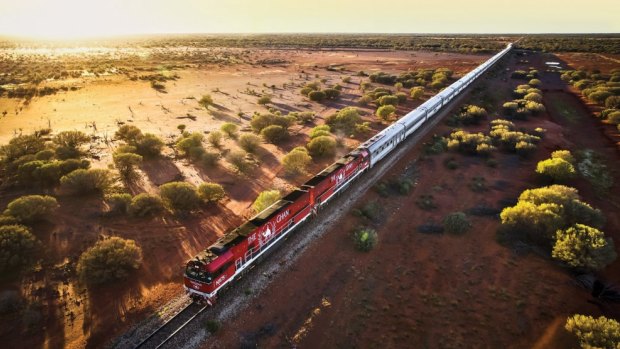
A 2979 kilometre trans-continental journey, north to south: The Ghan.
It's running again after being stopped in its tracks by COVID-19, which caused one of the most serious challenges and prolonged hiatuses in its more than 90-year history (the passage of its sister train, the Indian Pacific, meanwhile, remains blocked by a large obstacle called parochialism laid across its track).
I've travelled on the Ghan many times over the years, and it's always been largely the scenery, and those impressive facts, that have tended to dominate my experiences.
But such a long-distance passenger train is nothing without the people.
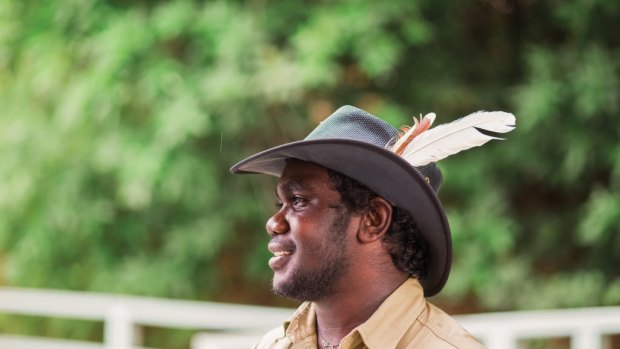
Raymond Fordimail of Nitmiluk Tours Katherine Gorge.
On this journey, now operating under COVID-safe measures, my plan is to chart the passage of the Ghan through the prism of those who keep it on the rails, both aboard the train and off, and make it unquestionably one of the world's greatest rail journeys.
DARWIN TO KATHERINE, 317 KILOMETRES
THE OUTBACK ENTERTAINER
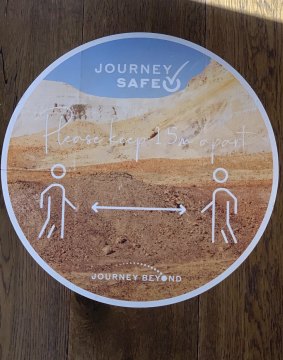
COVID-safe signage onboard.
After travelling the four hours or so between Darwin and Katherine on the first section of an extended four-day, three-night "Ghan Expedition" journey, with the heat outside clawing its way towards 40 degrees, it's time to "de-train".
I've chosen the Katherine Outback Experience as my first off-train experience. The outback show, based in the fourth largest Territory town of 10,000 souls, is the brainchild of horseman and entertainer Tom Curtain, who runs it with wife Annabel.
It's done well enough over the years to allow him to finance an open-sided roof across the twin-ringed arena to protect audiences from the searing Territory sun.

Dinner onboard the Ghan. Credit: Jacqui Way Photography
But that was before the pandemic struck, forcing the Ghan to cease running for five months. It could have been curtains for the couple's business but the Golden Guitar award winner and his team managed to pivot in his saddle (while strumming his guitar) and switch to brumby wrangling and entertaining fellow Territorians who, for a time, were unable to travel elsewhere in Australia. No, thankfully, the train is back.
The Katherine Outback Experience is a rollicking amalgam of country and western tunes, horse stunts and working dogs. "We don't want a schmicko show," he tells the audience. "We just want to show how things are done up here."
True to his word, 90 minutes or so later, Curtain concludes the show on a laconic, thoroughly un-Vegas note: "So does that make sense, in a roundabout way?"
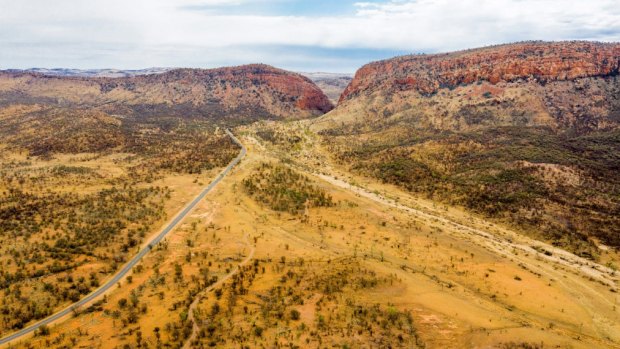
The scenery along the journey is truly remarkable.
It does. Riding on horse's back while standing and strumming a guitar and all. But now it's time to push on. The Ghan awaits for the next working dog leg of our journey with more than 2500 kilometres still left to run.
KATHERINE TO ALICE SPRINGS, 1183 KILOMETRES
THE ONBOARD CHEF
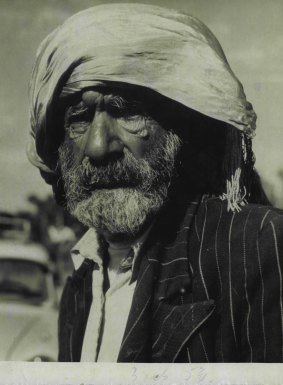
Saidal Mohomet, an Afghan camel driver, who has worked in the Territory for 65 years. Credit: Fairfax Media
What's for dinner? If an army supposedly marches on its stomach, a train like the Ghan rolls forward on its collective kinetic gut.
Surely, then, the most important figures on such a train aside from the drivers must be the chefs. All six to seven of them on the Ghan work in moving kitchens, that look the size of a horizontal telephone box.
Among them is genial Chetan Suri, 33, born in Chandigarh, India, the Ghan's chef de partie. His brother, Nitin, 36, is also a chef on the train.
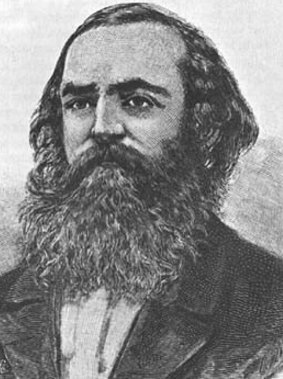
Explorer John Mcdouall Stuart.
"Even though India has a strong railway culture, I'd never thought I'd end up working on a train there, let alone Australia," says Chetan, who migrated to Australia 2008. "If you're temperamental this train is not for you.
"As a chef you need to be able to work in confined spaces. That means no yelling or screaming. At a restaurant you can go outside and have a smoke to calm down but not on a train."
Rather than being stuck in his tiny kitchen the whole time, Chetan, clad in his chef whites, likes to pass through the train and speak to the passengers, checking that they're content with their meals or if they have any special requests.
"When I started working on the train 10 years ago they were still serving Sunday roasts," he says. "The tastes of Australians have changed. We don't do Sunday roasts now."
Indeed, the menus in the Ghan's dining cars now include dishes that wouldn't be out of place at a top restaurant: grilled kangaroo loin, caramelised pumpkin with tomato sugo and chocolate praline mousse gateau.
ALICE SPRINGS TO COOBER PEDY, 687 KILOMETRES
THE RED CENTRE TOUR GUIDE
The next morning, as I gaze out the picture-perfect window of my cabin, after having left the blinds fully raised the night before for the full effect. It's as if God has changed the channel on nature's remote during the night.
Laying back on my double bed in luxurious platinum class, as a temporarily weak sun hoists itself above the horizon, the landscape has almost miraculously been transformed from the limey green of the tropics to the bloody red of the desert.
After Katherine our second stop is Alice Springs where (more choices, choices) I elect to take a tour to Simpsons Gap, or Rungutjirpa as it's called by the local Arrernte traditional owners, nestled in the vast West MacDonnell Ranges.
Our tour guide and coach driver today is Ceidleigh Bryce, as we pass a road sign just before the turnoff to Rungutjirpa someone with white chalk has neatly, though pointedly, crossed out the English destination names with the Indigenous names
Ceidleigh spent a year on the Ghan as a crew member and then she decided to quit the train and move to the unofficial Central Australian capital with a population a tad under 30,000.
"I've always loved Alice Springs and you can't live here without really loving it. It's a bit of a different world up here," says Ceideligh, 37.
"We don't have the fancy stores up here, But we make up for it by having the ability to drive 20 minutes out of town and roll out the swag and camp in a dry river bed under the stars."
Before we visit Simpsons Gap, Ceideligh escorts us to the top of the 634-metre Cassia Hill where the desert panorama is breathtaking -not only due to the pervasive dry heat we've negotiated to reach here.
Up here feels like we're mere sweaty stick figures in a 360-degree, wraparound Albert Namatjira canvas. At Simpsons Gap, the resident and rare black-footed rock-wallabies that inhabit its steep rocky slopes remain elusive.
But the place is aflutter with painted finches, attracted to the gap's permanent waterhole, a watery, reedy miracle in these parts, reached by a walk along a dry, sandy riverbed.
No wonder Ceidleigh has such a swagger about this harsh though swag-worthy part of the world.
COOBER PEDY TO PORT AUGUSTA, 542 KILOMETRES
THE OPAL MINER
After a gala dinner under the stars in the grounds of Alice Springs' restored 19th century Old Telegraph Station, the next morning the train arrives at Manguri, a lonely siding about 45-minutes from the opal-mining town of Coober Pedy, 850 kilometres from Adelaide.
Deep inside the sandstone-walled Quest mine (even down here there are hand-sanitising stations), where passengers from the Ghan are treated to a special subterranean lunch and tour, 76-year-old Mila Kovacik, is waiting to relate her story to them.
When she arrived in the cultural mixing pot of Coober Pedy 52 years ago, she was one of only a few women. She'd fled as far as she humanely could from the Soviet entry into her native Czechoslovakia (as it was known then) in 1968.
Josef, her husband-to-be, eventually followed her to Coober Pedy, where they built a tough though rewarding life around opal hunting.
But she bemoans today's plethora of red tape, in the form of strict permits and regulations around explosives - an essential tool for serious opal miners - that make it hard for industry aspirants.
Coober Pedy's multi-cultural identity, forged from post-war immigration, has faded. The floridly decorated underground Serbian Church on the other side of town no longer has its own priest.
But for Mila, this forbidding place, with its terrain badly blemished by leases, which served as a Hollywood stand-in for Mars, is, and will remain, home.
"It's still a really easy kind of life here," she says. "Even now it's a tight community where you know everybody."
PORT AUGUSTA TO ADELAIDE, 309 KILOMETRES
THE JOURNEY MANAGER
By the time we awake on the last morning of the journey, the landscape outside has undergone yet another transformation. The stark, desert country of Coober Pedy has been replaced by luxuriant farmlands as the Ghan edges closer to the South Australian capital.
There was a time when the Ghan's resolutely all-male crew were outfitted in crisp white shirts, black bow ties and matching vests. Nowadays the much more appropriate uniform is supplied by R.M. Williams.
The journey was more of a trip then, while today the trip is more of a journey, and one that calls not for a conductor but a journey manager.
An ever-smiling presence, Stacey Chau, 30, is the journey manager on this Ghan, her mobile workplace for a decade.
"One of my most important roles in this job, which I love, is reminding the crew that the Ghan isn't about going from A to B but about helping the guests aboard who have saved to fulfil their dream to travel aboard the train."
Aside from a medical issue which required a four-wheel drive ambulance to meet the train on its arrival at Manguri the trip has been more dream than nightmare. Happily, the passenger was deemed well enough to remain aboard and continue her journey.
Why would anyone want to leave the comforts of the Ghan unless entirely necessary? But, alas we must de-train, as they say.
By late morning the rest of us finally arrive in a considerably cooler Adelaide, four days and 3000 kilometres or so later straight down the long, character-filled backbone of the nation, fit, well, fact-rich and heavily-santised.
MAKING TRACKS: FIVE PEOPLE WHO MADE THE GHAN
THE EXPLORER
Colonial-era explorer John McDouall Stuart opened up Australia's interior for European settlement and, as a consequence, the original Central Australia Railway, colloquially known as the Ghan, between Adelaide and Alice Springs.
THE CAMELEER
Europeans would have found the outback even more forbidding had it not been for the importation of camels and their skilled Afghan cameleers (hence the name of the "Ghan") for transport.
THE PREMIER
In 1878 South Australian governor Sir William Jervois, a former British military engineer and diplomat, broke ground at Port Augusta on the railway that would eventually reach all the way to Alice Springs and, more than a century later, Darwin.
THE CHIEF ENGINEER
Scottish-born Norris Garrett Bell, commissioner of railways from 1917 to 1929, was instrumental in the planning and construction of the Oodnadatta to Alice Springs railway.
THE PRIME MINISTER
Former prime minister John Howard's vision for the completion of the historic missing link north-south railway between Darwin to Alice Springs was for freight not fun. But the Ghan was a major beneficiary of the nation-building project.
THE DETAILS
A twice-weekly four-day and three-night Ghan Expedition between Darwin and Adelaide between April and October, 2021, costs from $2829 a person. The fare includes all meals, wines, beverages and off-train experiences.
Fares for a three-day, two night journey between Adelaide and Darwin start from $1889 a person.
Anthony Dennis travelled as a guest of Journey Beyond, operators of the Ghan. See journeybeyondrail.com.au
Sign up for the Traveller Deals newsletter
Get exclusive travel deals delivered straight to your inbox. Sign up now.